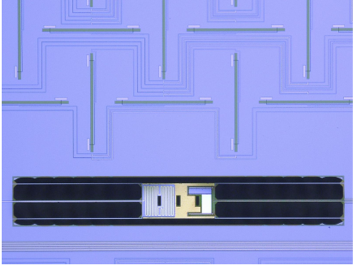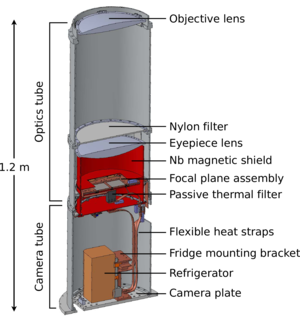BICEP2 and the Keck Array are parts of an ongoing program of small aperture CMB polarimeters operating at the South Pole. These experiments have produced the deepest maps of large angular scale microwave polarization ever made. In 2014, BICEP2 published the first detection of B-mode polarization at degree angular scales. This detection has shifted the focus of our field from producing progressively tighter upper limits to a new goal of precisely characterizing the detected signal and separating foregrounds from any CMB component. Part of this effort involves jointly analyzing data taken at many observing frequencies by multiple experiments, particularly the Planck satellite which currently provides the best data on dust polarization. Continuing observations with the Keck Array and BICEP3 will greatly improve the multi-frequency sensitivity of our maps and narrow down the possible contribution to the BICEP2 signal from a relic gravitational wave background predicted by theories of inflation.
Detector Technology

BICEP2 and the Keck Array use the proven optical design from BICEP1 but achieve a massive improvement in sensitivity by increasing the number of detectors in each focal plane. This was made possible by a new detector technology, developed by Jamie Bock’s group at Caltech and JPL, which combines sensitive transition-edge sensor (TES) bolometers with phased-array antennas in lithographically fabricated detector arrays.
The image at right shows a close up of one bolometer from a BICEP2 pixel. The top part of the image shows a few vertical and horizontal slots that are part of the two physically conincident but orthogonally polarized phased array antennas. The slots pick up microwave signals, which are then combined via a summing tree (visible in the image as thin lines routing around the slots). In the lower part of the image, you can see the bolometer island, which is suspended on long legs that provide thermal isolation from the focal plane. Microwave power collected by the antenna array is dissipated on the bolometer island and that change in thermal loading is detected by the TES. The difference in power detected between the two bolometers provides a measure of the amplitude of linear polarization along the axes defined by the antennas. Details of the detector design and performance can be found in our Detectors Paper, included in the bibliography below.
By operating these bolometers at cryogenic temperatures (270 mK), we can achieve background-limited performance for South Pole observing conditions, meaning that the detector noise is dominated by photon shot noise from the sum of atmospheric emission and CMB. Short of moving the telescope to outer space, the only way to improve the instrument sensitivity is to scale up the number of detectors. The BICEP/Keck observing program has progressed from BICEP2 (512 detectors) to the Keck Array, a modular combination of five BICEP2-like telescopes, to BICEP3, which began observing in 2015 and will soon feature 2560 detectors in a single larger telescope. Along with the increase in detector count, the continuing BICEP/Keck program allows us to expand the observing frequency coverage to distinguish what part of the detected signals are due to Galactic foregrounds or primordial CMB.
Optics and Characterization

The signature of primordial gravitational waves in the CMB is expected to peak at angular scales of roughly two degrees (about four times bigger than the full moon), so a survey targeting them does not require fine angular resolution. The BICEP2 and Keck Array telescopes (shown in a cutaway at left) use a small (26 cm) aperture cryogenic refracting telescope that achieves sufficient resolution for our science while minimizing thermal loading and optical systematics.
To properly interpret the maps of microwave polarization that we build from months and years of observation, we need precise knowledge of the detector beam shapes including their response to both polarized and unpolarized signals. We measure beam shapes through extensive calibration campaigns at the South Pole during austral summer. To enable these measurements, our group at Harvard has built several beam mapping sources, including large choppers for deep unpolarized maps, amplified broad-spectrum noise sources that are bright enough to measure far sidelobe response, and a rotating polarized source that can provide an absolute polarization angle calibration. Details of the BICEP2 and Keck Array optical characterization can be found in the Optics Paper
Status of Observations and Analysis
The BICEP2 telescope observed at 150 GHz from 2010 to 2012 and we published results from the full three-year dataset in 2014, along with companion papers describing the instrument design, systematics, optical characterization, and detectors. The Keck Array began operating in 2011 with three BICEP2-like telescopes, all at 150 GHz, then expanded to its full complement of five telescopes for the 2012 and 2013 seasons. In 2015 we published results from the 2012 and 2013 seasons of Keck Array, including a demonstration that Keck sees the same excess low-ℓ B-mode signal that was first detected by BICEP2.
We joined forces with the Planck Collaboration to produce a joint analysis of the 150 GHz data from BICEP2 and the Keck Array with multi-frequency data from Planck, also published in 2015. For this paper, I worked with two grad students at Harvard to develop a likelihood analysis that makes optimal use of all single-frequency and cross-frequency spectra in the combined dataset to constrain a multi-component model. This likelihood has been incorporated into the widely used CosmoMC code to make it available to the cosmology community. The BICEP–Keck–Planck joint analysis provides the most detailed understanding of degree-scale B-mode polarization in the Southern Hole. It reveals high significance detections of components from Galactic dust and CMB lensing, but no detection of a tensor component from inflation.
With an urgent need for more sensitive multi-frequency data, we are now taking advantage of the Keck Array’s modular design. Two of the five Keck Array telescopes were upgraded to observe at 95 GHz starting in the 2014 season. I am currently working hard, along with the rest of the BICEP/Keck Collaboration, on a new analysis that will fold in the new 95 GHz data to the multi-frequency likelihood analysis. For the 2015 observing season, we upgraded two additional Keck Array telescopes to 220 GHz observation and also deployed BICEP3, a new and larger telescope that will provide greatly improved sensitivity at 95 GHz. Early results from the Keck 220 GHz detectors look great, leading to plans to further improve high frequency sensitivity with Keck Array for 2016. Meanwhile, BICEP3 has completed a full year of operations and will be expanded to its full design sensitivity. The combination of these experiments will soon yield deep polarization maps at three frequencies for greatly improved CMB–foreground separation.
BICEP2 and Keck Array Publications
- Keck Array and BICEP2 Collaborations, BICEP2 / Keck Array VI: Improved Constraints On Cosmology and Foregrounds When Adding 95 GHz Data From Keck Array, to be submitted to Phys. Rev. Lett. [ADS, arXiv:1510.09217]
- BICEP2, Keck Array, and SPIDER Collaborations, Antenna-coupled TES Bolometers used in BICEP2, Keck Array, and SPIDER [Detectors Paper], ApJ, 812, 2, 176 [ADS, arXiv:1502.00619]
- Keck Array and BICEP2 Collaborations, BICEP2 / Keck Array V: Measurements of B-mode Polarization at Degree Angular Scales and 150 GHz by the Keck Array, ApJ, 811, 2, 126 [ADS, arXiv:1502.00643]
- BICEP2/Keck and Planck Collaborations, A Joint Analysis of BICEP2/Keck Array and Planck Data, Phys. Rev. Lett. 114, 10, 101301 [ADS, arXiv:1502.00612]
- BICEP2 and Keck Array Collaborations, BICEP2 / Keck Array IV: Optical Characterization and Performance of the BICEP2 and Keck Array Experiments [Optics Paper], ApJ, 806, 2, 206 [ADS, arXiv:1502.00596]
- BICEP2 Collaboration, BICEP2 III: Instrumental Systematics [Systematics Paper], accepted by ApJ [ADS, arXiv:1502.00608]
- BICEP2 Collaboration, BICEP2 II: Experiment and Three-year Data Set [Instrument Paper], ApJ, 792, 1, 62 [ADS, arXiv:1403.4302]
- BICEP2 Collaboration, BICEP2 I: Detection of B-mode Polarization at Degree Angular Scales, Phys. Rev. Lett. 112, 24, 241101 [ADS, arXiv:1403.3985]